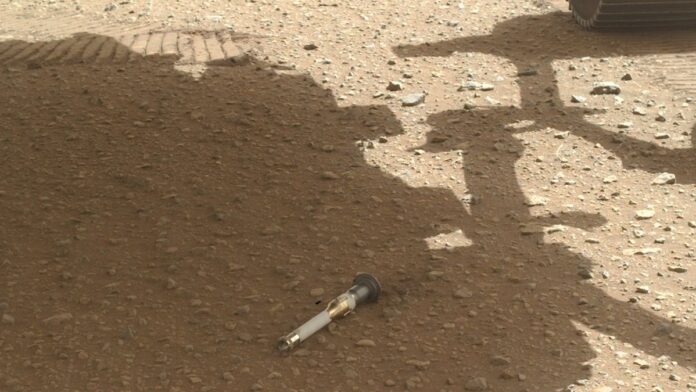NASA’s Perseverance Mars rover has dropped its fourth rock sample tube at a location in Jezero Crater, meaning its first backup sample depot is now 40% complete.
Perseverance, which landed on the Red Planet in February 2021, will stash 10 samples overall at the location called Three Forks, which is situated in an ancient river delta on the floor of the 28-mile-wide (45 kilometers) Jezero Crater.
“Sample Depot: 40% complete!,” the rover team celebrated via NASA’s Perseverance Twitter account (opens in new tab)on Wednesday (Jan. 4). “Another successful tube drop adds to my growing collection here at the ‘Three Forks’ location. Four of the 10 tubes I’m leaving here as a backup set are down.”
Perseverance has brought to Mars 43 6-inch-long (15.2 centimeters) titanium tubes, 38 of which will be filled with samples of Martian dust, dirt and rock. The remaining five tubes will be used to measure the cleanliness of the sampling system, NASA said in a statement (opens in new tab).
Related: Can we save Mars robots from death by dust?
NASA scientists are especially looking for samples from locations that may have harbored microbial life billions of years ago, hoping traces of these microbes could still be detectable in the material. NASA and the European Space Agency will work together to collect Perserverance’s samples and deliver them to Earth for detailed study, perhaps as early as 2033.
The stash at Three Forks is intended as a backup. Perseverance collects two samples from each of its target rocks, keeping one inside its belly. The primary goal is for the rover itself to deliver the samples to an incoming NASA lander, which will carry a rocket to blast the samples off the Martian surface. But in case Perseverance, which at the time of the sample return mission’s arrival could be over 10 years old, gets stuck somewhere, a pair of helicopters, which will arrive with the lander, will collect the backup samples and take them to the return vehicle, according to NASA (opens in new tab).
Perseverance dropped its first sample at Three Forks on Dec. 21. The whole operation was much more technically demanding than it might have looked at first glance. For example, the ground control team had to make sure that the sample tubes were in the correct position and had not rolled underneath the rover’s wheels. Just retrieving the sample from inside the rover took about one hour per sample, NASA said in the statement.
According to an earlier Perseverance Twitter thread (opens in new tab), scientists are not worried that notorious Martian dust storms could completely bury the precious tubes in dirt over the next decade. And in case so much dust collects on the tubes that they are no longer visible, Perseverance is making a careful record of their exact position so that “going back to them again later shouldn’t be an issue,” the rover team said in a tweet (opens in new tab) last month.
Follow Tereza Pultarova on Twitter @TerezaPultarova. Follow us on Twitter @Spacedotcom and on Facebook.

